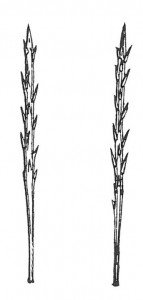Butterfly larvae are wanted by many animals. The larvae protect themselves by either coinciding with the surroundings or appearing unpleasant. They can smell or taste badly or be covered with stinging and annoying hair so that predators learn to stay away from these kinds of caterpillars the next time.
In Denmark, one must beware of the Tussock moth larvae, such as brown tail, Euproctis chrysorrhea and gypsy moths, Lymantria dispar, which may be very common in a few years. Furthermore, The Eastern Pine Processionary, Thaumetopoea pinivora have stinging hairs. In Denmark, the eastern pine processionary lives in Dueodde on Bornholm. In places where the hairy larvae live, the air can be full of broken, loose stinging hairs. In a few years, a species of the processionaries can be so numerous in oak forests in Southern Europe that people have to be warned against going into the forests due to floating larvae hair which gives eczema and other kinds of discomfort.





